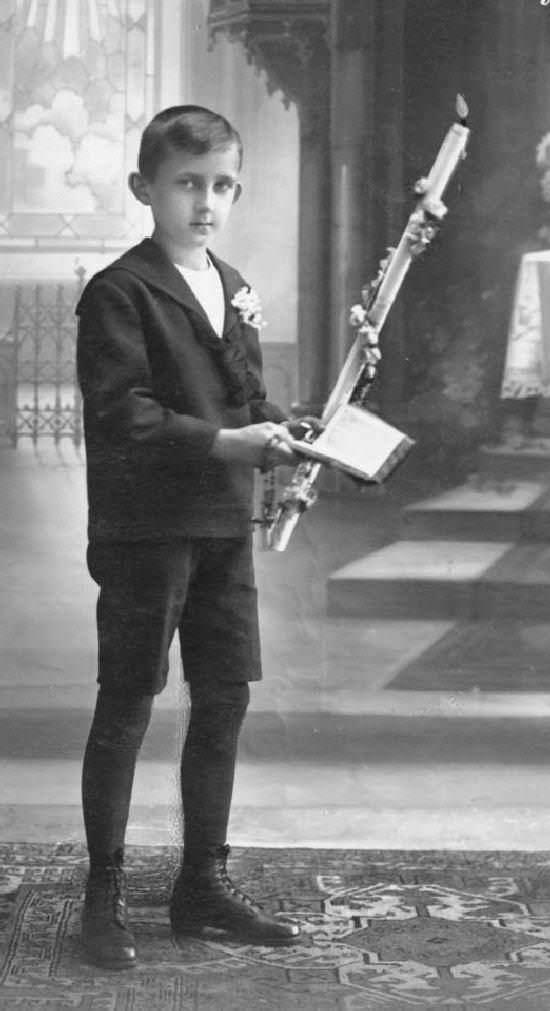
First Communion Country Trends: German 1932 Portraits

Figure 1.--This German boy was photographed in 1932. Note the candel he carries with a fake flame. Many German boys were photographed with these candels. In the small sampling we have, he was the only boy wearing a sailor suit. After the NAZI take over in 1933, long stockings became less common. A caption at the top of the card read, "In memory of this First Communion". (Zum Andenken an die erste Kommunion.) Image courtesy of the MD collection. Click on the image to see the back of the card.
|
This Boy
Outfit
Thus boy's hair is cut short with a left part. This boy wears a sailor suit. It is a very plain dark suit, presumably blue, without any white stripe detailing. Even the dickey is very plain--all white. Our sampling is too small to be sure, but it looks like German boys this age were wearing sailor suits less commonly for dressing up. This especially became true after 1933 when the NAZIs took power. They appear to have viewed the sailor suit suit as an outfit for younger boys. I'm not positive why this was, but it mass reflect social class connotations for several styles. Many NAZIs came from working-class or lower middle class back grounds. The sailor suit, a favorite of royalty, made have been especially popular with more affluent Germans. This boy looks slightly younger tha the other boiys, but perhaps that was because he is wearing a sailor suit. We wonnder if this sailor auit was brought special for First Communion. We think it probably was not, but this is a possability. Some German boys this age still wore sailor suits for best, but it was becomeing less common. He like the other boys has long over-the-knee stockings and high-top shoes.
First Communion items
As was common in Germany, he has the large candel with his rossary and Bible. This boy also has a flower corsage. His candel looks a little longer than the ones the others boys have.
Reader comments
One reader writes, "You may be correct. It also may be that this was the last big occasion for wearing the sailor suit and after this event he would wear a short pants suit. The suit appears (and I may be mistaken) a little small on him. Note the sleeves do not extend all the way (it is hard to tell with his arms bent) and the knee pants are at least an inch above the knees. The other boys wearing knees pants appear to wear ones cut much longer."
Background
This card was posted on April 2, 1932. The address reads "An Adolf Fecher, Offenburg Main Humboldstr." On the left: "Sendet Familie Siegel". So the address is: "To Adolf Fecher, Offenburg Main (that means the city of Offenburg on the river Main), Humboldstreet". This isnear Franfurt. On the left: "Sent by the Siegel Family". The post mark cancelation reads, ""Gegen Gicht, Rheuma und Nierenleiden: Kaiser Friedrich Quelle" mean "Against gout, rheuma (arthritis) and kidney disease: Emperor Frederick Spring", in other words,
it's an ad for medical well water, possibly in nearby Wiesbaden, where people
would go to the spa to cure those ailments. The upside down written words seem to be part of the return address of the Siegels. I can read their name F.Siegel, and then something like Rode St. 109. One poignent note. Siegel often is a Jewish name. It has many variations: Segal, Chagall, etc. Siegel means seal in German. Apparently Wolf had a Jewish friend. One wonders what happened to theor friemdship and the two boys after Hitler seizxed piower in 1933.
In the case of this portrait we happen to know not only when it was taken, but we know how this boys' friends were dressed. The image is a photo postcard, several of which were sent to the same boy and are post marked in 1932. Presumably friends in Germany exchanged their First Communion portraits with each other. It is interesting to note the similarities and differences among the suits the boys wear. The boys mostly wear old fashioned wing collars. One boy wears a sailor suit. The boys except for one wear short pants suits. All of the boys with short pants wear dark long stockings, although kneesocks had become much more common for boys this age. The boys look about 12-14 years old. The long stockings are not worn for warmth, but here appear to be considered more formal and appropriate for church than kneesocks. These photographs show not only what boys wore to their First Communions at the time, but a German boy's best dress suit in 1932. These were clearly not suits bought just for First Communion, but rather suits that were meant to be worn for best.
Christopher Wagner

Navigate the Boys' Historical Clothing Web Site religious pages:
[Return to the Main German first communion page]
[Return to the Main 1932 German First Communion page]
[First Communion]
[Confirmation]
[Ring bearer]
[Victorian wedding]
Navigate the Boys' Historical Clothing Web Site:
[Introduction]
[Activities]
[Biographies]
[Chronology]
[Clothing styles]
[Countries]
[Bibliographies]
[Contributions]
[FAQs]
[Glossaries]
[Satellite sites]
[Tools]
[Boys' Clothing Home]
Navigate the Historic Boys' Clothing Web chronological pages:
[The 1920s]
[The 1930s]
[The 1940s]
[The 1950s]
[The 1960s]
[The 1970s]
Navigate the Historic Boys' Clothing Web style pages:
[Short pants suits]
[Blazers]
[Jackets]
[Kilts]
[Sailor suits]
[Sailor hats]
[Ring bearer/page costumes]
[Shortalls]
Created: June 9, 2002
Last edited: June 11, 2002



